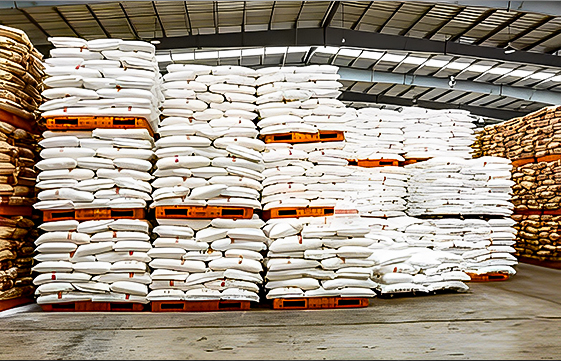Introduction
Polypropylene (PP) woven bags are heralded not only for their strength and durability but also for their role in environmental conservation. Made from weaving polypropylene fibers into a durable fabric, these bags offer a reusable and recyclable alternative to single-use plastics that dominate the packaging world. This introduction to PP woven bags sets the stage for a deeper exploration of their environmental benefits and the significant impact they can have on our planet’s health. As we delve into the specifics, it becomes clear that these bags are not just practical but pivotal in the journey toward sustainable packaging.
What are PP Woven Bags?
Polypropylene, commonly abbreviated as PP, is a type of thermoplastic polymer that’s widely used in a variety of applications, including packaging. Due to its resilient chemical structure, it provides a robust base material for creating durable products. When polypropylene is manufactured into woven polypropylene bags, it undergoes a process where the polymer is first extruded into tapes, which are then woven in a fashion similar to textiles to create a strong and flexible fabric.
Explanation of the Weaving Process:
The production of woven polypropylene bags starts with the melting and extrusion of polypropylene pellets. Workers melt these pellets at a high temperature and then extrude them into long, thin tapes. After cooling, they stretch these tapes to enhance their tensile strength and cut them to the required widths. Next, they weave the tapes on a circular or flat loom to form a fabric. This fabric gives the PP woven bags their distinctive appearance and texture.
Key Properties of PP Woven Bags:
- Durability: The strength of the woven fabric stands out as one of the most notable properties of PP woven bags. The weaving process enhances the inherent toughness of polypropylene, allowing these bags to handle heavy loads and harsh conditions without tearing.
- Chemical Resistance: Polypropylene resists many chemical solvents, bases, and acids, making woven polypropylene bags ideal for packaging chemicals, fertilizers, and other potentially corrosive materials without degrading.
- Lightweight: PP woven bags are incredibly lightweight, which cuts shipping costs and makes them easy to handle during loading and unloading processes.
- Recyclability: Woven polypropylene bags are recyclable, which reduces the waste associated with their use and supports environmental sustainability efforts.
Reusable Nature of PP Woven Bags
One of the significant advantages of PP woven bags over conventional packaging materials is their reusability. Reusability is crucial in reducing waste and promoting sustainable consumption practices.
Contrast with Single-Use Plastics
Single-use plastics are typically designed to be discarded after one use, contributing significantly to environmental pollution and landfill waste. In contrast, woven polypropylene bags are built to last. This durability significantly reduces the need to produce and dispose of single-use bags, reducing resource consumption and waste generation.
Consumer Practices for Reusing PP Woven Bags
- Home Storage: Consumers can use PP woven bags to store items that require protection from moisture, such as seasonal clothing, gardening tools, or even documents.
- Pet Bedding: You can repurpose old PP woven bags into bedding for pets by adding soft materials inside. This creates a durable and easy-to-clean sleeping area.
- Plant Potting: Gardening enthusiasts can use these bags as bases for potting plants. Their durability and moisture resistance make them ideal for creating a healthy environment for plant growth.
Recyclability of PP Woven Bags
The recyclability of PP woven bags underscores their role as a sustainable packaging option. Made from polypropylene woven fabric, these bags can be recycled after their usable life, which helps in reducing the environmental impact of waste materials.
Overview of the Recycling Process for Polypropylene
- Cleaning: After sorting, workers clean the bags to remove any dirt, debris, or other contaminants. This step ensures that the recycled polypropylene remains pure and free from impurities that could degrade its quality.
- Shredding and Granulating: Workers then shred the clean polypropylene bags into small pieces, which they further granulate into pellets. These pellets serve as the raw material for producing new polypropylene products.
- Reprocessing: Manufacturers melt and extrude the pellets to create new polypropylene woven fabric or other polypropylene-based products. This step completes the recycling loop, turning old bags into new materials.
Solutions to Enhance Recycling
- Improved Recycling Facilities: Investing in better recycling technology and infrastructure can enhance the efficiency of processing PP woven bags.
- Public Education Campaigns: Raising awareness about the importance of recycling PP woven bags and how to properly dispose of them can increase recycling rates.
Current Initiatives and Technologies
- Advanced Sorting Technologies: Some recycling facilities now use sophisticated sorting technologies, such as near-infrared (NIR) scanners, to identify and separate polypropylene more accurately.
- Chemical Recycling: Emerging technologies that break down polypropylene to its molecular components are being developed. These technologies can handle a broader range of contaminants and can potentially recycle polypropylene more thoroughly.
Reducing the Use of Single-Use Plastics
The environmental impact of single-use plastics is profound and far-reaching, prompting a global movement towards more sustainable alternatives. Thanks to their durability and reusability, PP woven bags stand out as a viable option to reduce reliance on single-use plastics. Understanding the environmental challenges posed by single-use plastics and exploring the benefits of switching to PP woven bags can illuminate paths toward more sustainable consumption patterns.
Statistics on the Environmental Impact of Single-Use Plastics
- Global Production and Waste: Manufacturers produce over 300 million tons of plastic every year, with a significant portion consisting of single-use plastics that end up in oceans and landfills.
- Wildlife and Ecosystems: Plastic debris kills approximately 100,000 marine animals annually, and researchers have found microplastics in over 90% of seabirds.
- Resource Inefficiency: People use a single plastic bag for an average of just 12 minutes before disposing of it, yet it can take up to 500 years to decompose in the environment.
Benefits of Switching to PP Woven Bags
- Durability and Reusability: Unlike single-use plastics, you can use PP woven bags multiple times over an extended period.
- Resource Efficiency: Producing PP woven bags consumes less energy compared to traditional plastic bags.
PP woven bags offer substantial environmental benefits, including durability, reusability, and recyclability, making them a superior alternative to single-use plastics. Their adoption across various industries demonstrates a commitment to reducing plastic waste and enhancing sustainability.




